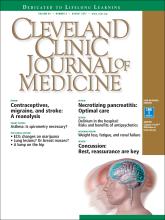Article Figures & Data
Tables
Agent Haloperidol Olanzapine Quetiapine Risperidone Aripiprazole Dosage forms Oral tablets, solution
Intramuscular and intravenous solutionsOral tablets, disintegrating tablets
Intramuscular solutionOral tablets, solution Oral tablets, disintegrating tablets, solution Oral tablets, solution, distintegrating tablets
Intramuscular solutionStarting dose 0.5–1 mg twice a day 2.5–5 mg twice a day 12.5–25 mg twice a day 0.5 mg twice a day 1 mg twice a day Half-life (hours) 12–38 21–54 6 20 75 Clearance Hepatic Hepatic Hepatic Hepatic Hepatic Common adverse effects Akathisia Dystonia Parkinsonism Akathisia Parkinsonism Agitation Parkinsonism Akathisia Agitation Effects on corrected QT interval Oral, intramuscular: Mild
Intravenous: ModerateMild Mild Mild None Orthostatic hypotension Mild Moderate Severe Severe Moderate Anticholinergic effectsa Mild Severe Moderate Mild Mild Sedation Mild Moderate Severe Moderate Moderate Drug-drug interactions (CYP450 activity) Substrate of: CYP1A2 (minor) CYP2D6 (major) CYP3A4 (major)
Inhibits CYP2D6 (moderate)Substrate of: CYP1A2 (major) CYP2D6 (minor) Substrate of: CYP2D6 (minor) CYP3A4 (major) Substrate of: CYP2D6 (major) CYP3A4 (minor) Substrate of: CYP2D6 (major) CYP3A4 (major) Special considerations Minimal effect on vital signs
May worsen stiffness and motor symptoms in Parkinson diseaseComes in dissolvable form
Helpful for cancer-related nausea
Do not combine with parenteral benzodiazepines due to risk of respiratory depression
May worsen control of diabetesConsider in Parkinson disease Comes in dissolvable form May be useful for hypoactive delirium
No known effect on QTc↵a Dry mouth, constipation, urinary retention.
Based on information from references 23–25.






